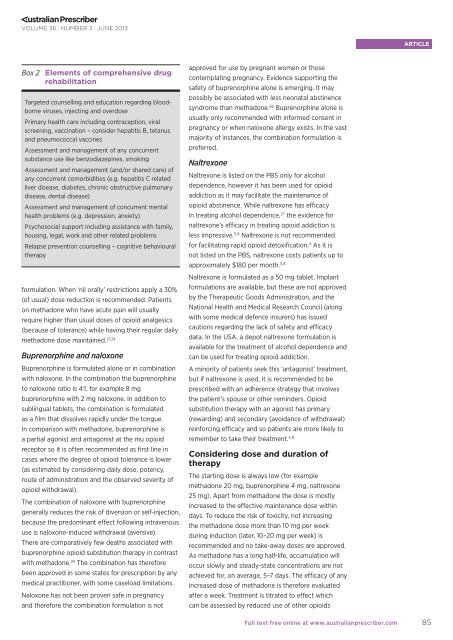download the full PDF issue - Australian Prescriber
download the full PDF issue - Australian Prescriber
download the full PDF issue - Australian Prescriber
Create successful ePaper yourself
Turn your PDF publications into a flip-book with our unique Google optimized e-Paper software.
VOLUME 36 : NUMBER 3 : JUNE 2013<br />
ARTICLE<br />
Box 2 Elements of comprehensive drug<br />
rehabilitation<br />
Targeted counselling and education regarding bloodborne<br />
viruses, injecting and overdose<br />
Primary health care including contraception, viral<br />
screening, vaccination – consider hepatitis B, tetanus<br />
and pneumococcal vaccines<br />
Assessment and management of any concurrent<br />
substance use like benzodiazepines, smoking<br />
Assessment and management (and/or shared care) of<br />
any concurrent comorbidities (e.g. hepatitis C related<br />
liver disease, diabetes, chronic obstructive pulmonary<br />
disease, dental disease)<br />
Assessment and management of concurrent mental<br />
health problems (e.g. depression, anxiety)<br />
Psychosocial support including assistance with family,<br />
housing, legal, work and o<strong>the</strong>r related problems<br />
Relapse prevention counselling – cognitive behavioural<br />
<strong>the</strong>rapy<br />
formulation. When ‘nil orally’ restrictions apply a 30%<br />
(of usual) dose reduction is recommended. Patients<br />
on methadone who have acute pain will usually<br />
require higher than usual doses of opioid analgesics<br />
(because of tolerance) while having <strong>the</strong>ir regular daily<br />
methadone dose maintained. 21,24<br />
Buprenorphine and naloxone<br />
Buprenorphine is formulated alone or in combination<br />
with naloxone. In <strong>the</strong> combination <strong>the</strong> buprenorphine<br />
to naloxone ratio is 4:1, for example 8 mg<br />
buprenorphine with 2 mg naloxone. In addition to<br />
sublingual tablets, <strong>the</strong> combination is formulated<br />
as a film that dissolves rapidly under <strong>the</strong> tongue.<br />
In comparison with methadone, buprenorphine is<br />
a partial agonist and antagonist at <strong>the</strong> mu opioid<br />
receptor so it is often recommended as first line in<br />
cases where <strong>the</strong> degree of opioid tolerance is lower<br />
(as estimated by considering daily dose, potency,<br />
route of administration and <strong>the</strong> observed severity of<br />
opioid withdrawal).<br />
The combination of naloxone with buprenorphine<br />
generally reduces <strong>the</strong> risk of diversion or self-injection,<br />
because <strong>the</strong> predominant effect following intravenous<br />
use is naloxone-induced withdrawal (aversive).<br />
There are comparatively few deaths associated with<br />
buprenorphine opioid substitution <strong>the</strong>rapy in contrast<br />
with methadone. 25 The combination has <strong>the</strong>refore<br />
been approved in some states for prescription by any<br />
medical practitioner, with some caseload limitations.<br />
Naloxone has not been proven safe in pregnancy<br />
and <strong>the</strong>refore <strong>the</strong> combination formulation is not<br />
approved for use by pregnant women or those<br />
contemplating pregnancy. Evidence supporting <strong>the</strong><br />
safety of buprenorphine alone is emerging. It may<br />
possibly be associated with less neonatal abstinence<br />
syndrome than methadone. 26 Buprenorphine alone is<br />
usually only recommended with informed consent in<br />
pregnancy or when naloxone allergy exists. In <strong>the</strong> vast<br />
majority of instances, <strong>the</strong> combination formulation is<br />
preferred.<br />
Naltrexone<br />
Naltrexone is listed on <strong>the</strong> PBS only for alcohol<br />
dependence, however it has been used for opioid<br />
addiction as it may facilitate <strong>the</strong> maintenance of<br />
opioid abstinence. While naltrexone has efficacy<br />
in treating alcohol dependence, 27 <strong>the</strong> evidence for<br />
naltrexone’s efficacy in treating opioid addiction is<br />
less impressive. 5,8 Naltrexone is not recommended<br />
for facilitating rapid opioid detoxification. 4 As it is<br />
not listed on <strong>the</strong> PBS, naltrexone costs patients up to<br />
approximately $180 per month. 5,8<br />
Naltrexone is formulated as a 50 mg tablet. Implant<br />
formulations are available, but <strong>the</strong>se are not approved<br />
by <strong>the</strong> Therapeutic Goods Administration, and <strong>the</strong><br />
National Health and Medical Research Council (along<br />
with some medical defence insurers) has <strong>issue</strong>d<br />
cautions regarding <strong>the</strong> lack of safety and efficacy<br />
data. In <strong>the</strong> USA, a depot naltrexone formulation is<br />
available for <strong>the</strong> treatment of alcohol dependence and<br />
can be used for treating opioid addiction.<br />
A minority of patients seek this ‘antagonist’ treatment,<br />
but if naltrexone is used, it is recommended to be<br />
prescribed with an adherence strategy that involves<br />
<strong>the</strong> patient’s spouse or o<strong>the</strong>r reminders. Opioid<br />
substitution <strong>the</strong>rapy with an agonist has primary<br />
(rewarding) and secondary (avoidance of withdrawal)<br />
reinforcing efficacy and so patients are more likely to<br />
remember to take <strong>the</strong>ir treatment. 5,8<br />
Considering dose and duration of<br />
<strong>the</strong>rapy<br />
The starting dose is always low (for example<br />
methadone 20 mg, buprenorphine 4 mg, naltrexone<br />
25 mg). Apart from methadone <strong>the</strong> dose is mostly<br />
increased to <strong>the</strong> effective maintenance dose within<br />
days. To reduce <strong>the</strong> risk of toxicity, not increasing<br />
<strong>the</strong> methadone dose more than 10 mg per week<br />
during induction (later, 10–20 mg per week) is<br />
recommended and no take-away doses are approved.<br />
As methadone has a long half-life, accumulation will<br />
occur slowly and steady-state concentrations are not<br />
achieved for, on average, 5–7 days. The efficacy of any<br />
increased dose of methadone is <strong>the</strong>refore evaluated<br />
after a week. Treatment is titrated to effect which<br />
can be assessed by reduced use of o<strong>the</strong>r opioids<br />
Full text free online at www.australianprescriber.com<br />
85
















